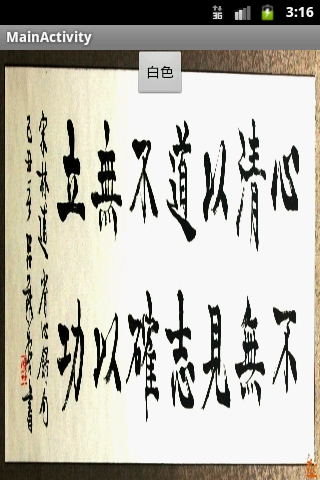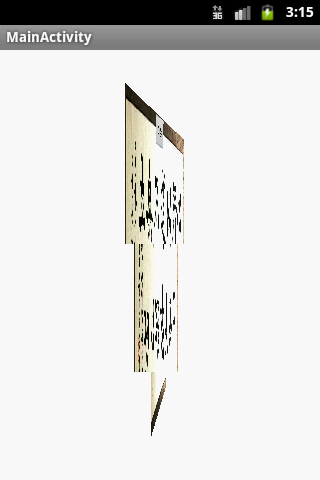
- 总结Android中多线程更新应用的页面信息的方式
- android帮助文档打开慢的三种解决方法
- android 退出程序解决内存释放的问题
- Android笔记之:深入为从右向左语言定义复杂字串的详解
- android接收到蓝牙配对请求时如何点亮屏幕具体实现
- Android 解决嵌套Fragment无法接收onCreateOptionsMenu事件的问题
- Android 再按一次退出程序的实现方法
- Android中设置RadioButton在文字右边的方法实例
- Android学习笔记(二)App工程文件分析
- Android实现EditText内容保存为Bitmap的方法
- android使用videoview播放视频
- Android采用File形式保存与读取数据的方法
- Android实现Flip翻转动画效果
- 快速搞懂Android口令加密(一)
- Android加载图片内存溢出问题解决方法
- Android编程使用Intent传递对象的方法分析
- android图片压缩的3种方法实例
- Android RecyclerView详解之实现 ListView GridView瀑布流效果
- Android菜单操作之创建并响应菜单
- Android 数据存储方式有哪几种
- android网络编程之android连接网络的简单示例代码
- Android客户端软件开发_19、下载模块的的进一步实现分析和优化
- Android之使用Android-query框架开发实战(一)
- Android 启动activity的4种方式及打开其他应用的activity的坑
- Android中Notification用法实例总结
- 浅析Android 手机卫士设备管理权限锁屏
- Android开发 旋转屏幕导致Activity重建解决方法
- Android弹出窗口实现方法
- Android实现捕获TextView超链接的方法
- Android中asset文件夹与raw文件夹的区别深入解析
基于Android实现3D翻页效果
最近做了一个简单的3D效果翻页特效,先说说我的思路吧,首先我这个翻页效果并不是两个Activity之间的跳转,而是在同一个activity类切换不同的view而已。我现在的做法是单击一个button然后Gone当前的布局,然后把需要呈现的布局visible,在隐藏当前布局的时候启动动画,然后给动画添加监听,在动画结束时开始另外一个view的入场动画就行了。
下面来看下我的主页面的布局文件:
<FrameLayout xmlns:android="http://schemas.android.com/apk/res/android" android:id="@+id/container" android:layout_width="fill_parent" android:layout_height="fill_parent" > <include android:layout_width="fill_parent" android:layout_height="fill_parent" layout="@layout/layout2" /> <include android:layout_width="fill_parent" android:layout_height="fill_parent" layout="@layout/layout1" /> </FrameLayout>
我这个布局文件使用<include>标签包含了另外2个布局文件,这些布局文件才是呈现数据的,下面是另外2个布局文件:
layout1:
<?xml version="1.0" encoding="utf-8"?> <LinearLayout xmlns:android="http://schemas.android.com/apk/res/android" android:layout_width="match_parent" android:layout_height="match_parent" android:background="@drawable/test1" android:orientation="vertical" android:id="@+id/container1" > <Button android:id="@+id/bt_towhile" android:layout_width="wrap_content" android:layout_height="wrap_content" android:layout_gravity="center" android:text="白色" /> </LinearLayout>
layout2:
<?xml version="1.0" encoding="utf-8"?> <LinearLayout xmlns:android="http://schemas.android.com/apk/res/android" android:id="@+id/container2" android:layout_width="match_parent" android:layout_height="match_parent" android:background="@drawable/test2" android:orientation="vertical" > <Button android:id="@+id/bt_toblack" android:layout_width="wrap_content" android:layout_height="wrap_content" android:layout_gravity="center" android:text="黑色" /> </LinearLayout>
我这里只是举个例子并没有放什么实际的类容,只是放了2个button,当我点击其中一个跳转到另外一个layout。
有了布局文件那我们就开始要实现功能了,我们的想法是点击按钮的时候开始一个动画等动画结束时再开启另外一个动画并隐藏和展示layout1和layout2。
下面是我写的一个动画工具类源码:
package com.test.view;
import android.view.View;
import android.view.ViewGroup;
import android.view.animation.Animation;
import android.view.animation.DecelerateInterpolator;
public class RotateAnimationUtil {
private ViewGroup context;
private View[] views;
public RotateAnimationUtil(ViewGroup context, View... views) {
super();
this.context = context;
this.views = views;
}
/**
* 应用自定义的Rotate3DAnimation动画
*
* @param flag
* 当前控件的顺序坐标
* @param startDegress
* 开始的角度
* @param endDegress
* 结束的角度
*/
public void applyRotateAnimation(int flag, float startDegress,
float endDegress) {
final float centerX = context.getWidth() / 2.0f;
final float centerY = context.getHeight() / 2.0f;
Rotate3DAnimation rotate = new Rotate3DAnimation(startDegress,
endDegress, centerX, centerY, 310.0f, true);
rotate.setDuration(1000);
rotate.setFillAfter(false);
rotate.setInterpolator(new DecelerateInterpolator());
rotate.setAnimationListener(new DisplayNextView(flag));
context.startAnimation(rotate);
}
private final class DisplayNextView implements Animation.AnimationListener {
private final int mFlag;
private DisplayNextView(int flag) {
mFlag = flag;
}
public void onAnimationStart(Animation animation) {
}
// 动画结束
public void onAnimationEnd(Animation animation) {
context.post(new SwapViews(mFlag));
}
public void onAnimationRepeat(Animation animation) {
}
}
/**
* 新开一个线程动画结束后再开始一次动画效果实现翻屏特效
*
* @author yangzhiqiang
*
*/
private final class SwapViews implements Runnable {
private final int mFlag;
public SwapViews(int mFlag) {
this.mFlag = mFlag;
}
public void run() {
final float centerX = context.getWidth() / 2.0f;
final float centerY = context.getHeight() / 2.0f;
Rotate3DAnimation rotation;
if (mFlag > -1) {
views[0].setVisibility(View.GONE);
views[1].setVisibility(View.VISIBLE);
views[1].requestFocus();
rotation = new Rotate3DAnimation(270, 360, centerX, centerY,
310.0f, false);
} else {
views[1].setVisibility(View.GONE);
views[0].setVisibility(View.VISIBLE);
views[0].requestFocus();
rotation = new Rotate3DAnimation(90, 0, centerX, centerY,
310.0f, false);
}
rotation.setDuration(1000);
rotation.setFillAfter(false);
rotation.setInterpolator(new DecelerateInterpolator());
// 开始动画
context.startAnimation(rotation);
}
}
}
解释一下这个类的构造方法:
public RotateAnimationUtil(ViewGroup context, View... views) {
super();
this.context = context;
this.views = views;
}
有2个参数,第一个参数就是我们的主布局页面的FrameLayout,第2个参数就是我们要进行动画切换的2个子layout,我这使用的是一个可变长参数只是为了方便而已。
public void applyRotateAnimation(int flag, float startDegress,float endDegress)方法第一个参数是标记当前是第是从哪个个layout跳转,因外我们必须知道当前开始跳转的layout才能推算角度。
下面是我自定义动画的源码:
package com.test.view;
import android.graphics.Camera;
import android.graphics.Matrix;
import android.view.animation.Animation;
import android.view.animation.Transformation;
public class Rotate3DAnimation extends Animation {
private final float mFormDegress;
private final float mToDegress;
private final float mCenterX;
private final float mCenterY;
/**
* 控制z轴的一个常量值,主要是控制动画的升降距离
*/
private final float mDepthz;
/**
* 控制z轴是像上移动还是向下移动,从而实现升降效果
*/
private final boolean mReverse;
private Camera mCamera;
public Rotate3DAnimation(float formDegress, float toDegress, float centerX,
float centerY, float depthz, boolean reverse) {
super();
this.mFormDegress = formDegress;
this.mToDegress = toDegress;
this.mCenterX = centerX;
this.mCenterY = centerY;
this.mDepthz = depthz;
this.mReverse = reverse;
}
@Override
public void initialize(int width, int height, int parentWidth,
int parentHeight) {
super.initialize(width, height, parentWidth, parentHeight);
mCamera = new Camera();
}
/**
* interpolatedTime 取值范围是0-1之间当每次,当动画启动后会系统会不停的调用applyTransformation方法,
* 并改变interpolatedTime的值
*/
@Override
protected void applyTransformation(float interpolatedTime, Transformation t) {
final float formDegress = mFormDegress;
// 通过差点值计算出转变的角度
float degress = formDegress
+ ((mToDegress - formDegress) * interpolatedTime);
final float centerX = mCenterX;
final float centerY = mCenterY;
final Camera camera = mCamera;
// 得到当前矩阵
Matrix matrix = t.getMatrix();
// 报错当前屏幕的状态
camera.save();
// 判断是降还是升
if (mReverse) {
// 正向改变Z轴角度
camera.translate(0.0f, 0.0f, mDepthz * interpolatedTime);
} else {
// 反向改变Z轴角度
camera.translate(0.0f, 0.0f, mDepthz * (1.0f - interpolatedTime));
}
// 旋转Y轴角度
camera.rotateY(degress);
// 把当前改变后的矩阵信息复制给Transformation的Matrix
camera.getMatrix(matrix);
// 根据改变后的矩阵信息从新恢复屏幕
camera.restore();
// 让动画在屏幕中间运行
matrix.preTranslate(-centerX, -centerY);
matrix.postTranslate(centerX, centerY);
}
}
如果你不需要沉降效果那么你把下面的代码删除掉即可:
if (mReverse) {
// 正向改变Z轴角度
camera.translate(0.0f, 0.0f, mDepthz * interpolatedTime);
} else {
// 反向改变Z轴角度
camera.translate(0.0f, 0.0f, mDepthz * (1.0f - interpolatedTime));
}
好了核心代码已经上完,下面是主界面代码:
package com.test.rotateanimation;
import android.app.Activity;
import android.os.Bundle;
import android.view.Menu;
import android.view.View;
import android.view.ViewGroup;
import android.widget.Button;
import android.widget.FrameLayout;
import android.widget.LinearLayout;
import com.test.view.RotateAnimationUtil;
public class MainActivity extends Activity {
private FrameLayout container;
private LinearLayout container1;
private LinearLayout container2;
private RotateAnimationUtil rotateAnimationUtil;
private Button bt_towhile;
private Button bt_toblack;
@Override
public void onCreate(Bundle savedInstanceState) {
super.onCreate(savedInstanceState);
setContentView(R.layout.activity_main);
initView();
bt_towhile.setOnClickListener(new View.OnClickListener() {
@Override
public void onClick(View v) {
rotateAnimationUtil.applyRotateAnimation(1, 0, 90);
}
});
bt_toblack.setOnClickListener(new View.OnClickListener() {
@Override
public void onClick(View v) {
rotateAnimationUtil.applyRotateAnimation(-1, 0, -90);
}
});
// 设置当前View控件的缓存
container
.setPersistentDrawingCache(ViewGroup.PERSISTENT_ANIMATION_CACHE);
}
private void initView() {
container = (FrameLayout) findViewById(R.id.container);
bt_toblack = (Button) findViewById(R.id.bt_toblack);
bt_towhile = (Button) findViewById(R.id.bt_towhile);
container1 = (LinearLayout) findViewById(R.id.container1);
container2 = (LinearLayout) findViewById(R.id.container2);
rotateAnimationUtil = new RotateAnimationUtil(container, container1,
container2);
}
@Override
public boolean onCreateOptionsMenu(Menu menu) {
getMenuInflater().inflate(R.menu.activity_main, menu);
return true;
}
}
下面是运行效果,剪切效果不好,呵呵.




源码下载:http://xiazai.jb51.net/201606/yuanma/RotateAnimation(jb51.net).rar
以上就是本文的全部内容,希望对大家的学习有所帮助,也希望大家多多支持脚本之家。
- 上一篇文章: Android编写简单的聊天室应用
- 下一篇文章: Android实现listview动态加载数据分页的两种方法
- 详解Android应用开发中Intent的作用及使用方
- Android 屏幕双击事件的捕获简单示例
- Android多线程处理机制中的Handler使用介绍
- Android编程实现给Button添加图片和文字的方
- Android 屏蔽和捕获Home键的示例代码
- Android 访问文件权限的四种模式介绍
- android开发教程之android的handler使用方法